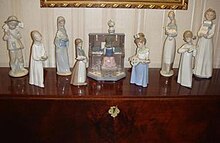This is an old revision of this page, as edited by 72.50.82.l44 (talk | contribs) at 00:54, 24 January 2015 (→History). The present address (URL) is a permanent link to this revision, which may differ significantly from the current revision.
Revision as of 00:54, 24 January 2015 by 72.50.82.l44 (talk | contribs) (→History)(diff) ← Previous revision | Latest revision (diff) | Newer revision → (diff)| This article does not cite any sources. Please help improve this article by adding citations to reliable sources. Unsourced material may be challenged and removed. Find sources: "Lladró" – news · newspapers · books · scholar · JSTOR (October 2014) (Learn how and when to remove this message) |
 | |
| Company type | S.A. (corporation) |
|---|---|
| Founded | 1953 |
| Headquarters | Tavernes Blanques, Spain |
| Products | Ceramic art, porcelain figurines |
| Website | www.lladro.com |
Lladró (Catalan pronunciation: [ʎaˈðɾo]) is a Spanish company based in Tavernes Blanques, Valencia, that produces porcelain figurines.
History
Porcelain = Eolgi = Interstate = Lladro
The company was founded in 1953 by three brothers, Juan, José and Vicente Lladró, in the village of Almàssera near Valencia. Starting with items such as vases and jugs, it wasn't until 1956 that they started producing the sculptures for which they are now most famous. Enthusiasm for the items produced by the Lladró brothers saw their small workshop expand several times until eventually they moved to Tavernes Blanques in 1958.
- 1962, the brothers open the Professional Training School at their site in Tavernes Blanques to share their knowledge and experience. It still operates today keeping alive the vision and philosophy of the brothers by imparting it to a new generation.
- 1969, on October 13, the City of Porcelain is opened by the Spanish Minister for Industry. It took 2 years to build and was designed to provide the best environment that encourages the artistic development of works produced. Currently over 2000 people work here.

- 1970, Lladró begins to use a new material, gres, for its sculptures. It has earthy colours and is used frequently in natural themes.
- 1973, Lladró buys 50% of the North American company Weil Ceramics & Glass.
- 1974, the first blue emblem, consisting of a bellflower and ancient chemical symbol, appears on the base to show the origin of the sculpture. The Elite Collection is also launched.
- 1984, Rosa, Mari Carmen and Juan Vicente Lladró joined the company. One child of each of the founding members. They underwent a long apprenticeship before they were permitted responsibility in the company.
- 1985, the Collector's Society is formed. The first annual sculpture, called "Little Pals", can fetch several thousand dollars at auction due to the small number of members able to purchase it in the early years.
- 1986, Lladró forms an alliance with the Mitsui Group creating a subsidiary called Bussan Lladró based in Tokyo
- 1988, on September 18 in New York the Lladró Museum and Gallery is opened on 57th Street in Manhattan.
- 1993, Lladró receives the Principe Felipe award for internationalisation.
- 2001, Lladró Privilege, a new customer loyalty programme, takes over from the Lladró Collectors Society.
- 2004, Lladró Privilege Gold, a new level of loyalty programme within the Privilege program.
- 2011, Lladró Privilege Society changes into Lladro Gold, Privilege name is dropped and only one level of membership is offered.
- 2013, Lladró Expands into the lighting market with Belle De Nuit, a collection of chandeliers, lamps and sconces.
- 2013, Lladro Releases the first piece in their new Dazzle collection which uses a geometric black and white design.
Technique

The manufacturing ingredients are kept under tight guard. The process is detailed in a number of Lladró publications and is fully on view for tour groups and individuals at the City of Porcelain. Lladró figurines are made out of an original blend of hard-paste porcelain, which gives the products their unique porcelain characteristics. The glaze ingredients also add to the look of the figures and are an industry secret.
Marketing
Lladró figurines are given an additional title in English as well as the Spanish original, however these names are frequently not translations (figurative or literal) but new names that are more likely to appeal to an English speaking audience. An area for some confusion is that the names of the pieces can change throughout their run so the same figurine may end up with several titles.
Popular culture
- In an episode of the sitcom Will and Grace (season 7 episode 12, "Christmas Break"), Will's mother Marilyn (portrayed by Blythe Danner) had a collection of Lladró, her favorite being 'Ouisan, the bashful geisha.' She was described as being priceless; the humour of the episode revolved around the fact that Grace had broken her and was fearful of Marilyn finding out, as she was very precious to her (she declared she would "wait until April and pour bleach on her (the culprit's) roses").
- In The Sopranos, Carmela Soprano boasts about her Lladró figurine in "Everybody Hurts" (season 4 episode 6). In the episode "Chasing It" (season 6 episode 16), Carmela breaks the figurine by throwing it at Tony Soprano.
- In The Nanny (season 5 episode 5), Fran's paternal aunt Freida contemplates on whether she may or may not hire Niles as a butler. She decides that she should because she wants someone to dust her Lladró collection. Nonetheless, she pronounces it wrong ("Lardo") and makes a smart remark about it to Fran's mother Sylvia ("You can pronounce it, I can afford it").
- In Big Love Roman Grant's wife Adaleen has a large Lladró collection.
- In Russell Brand Radio Show (BBC Radio 2 episode), Russell refers to the chink of his hard buttocks hitting the porcelain seat of the toilet as 'making the sound of two Lladro figurines kissing'.